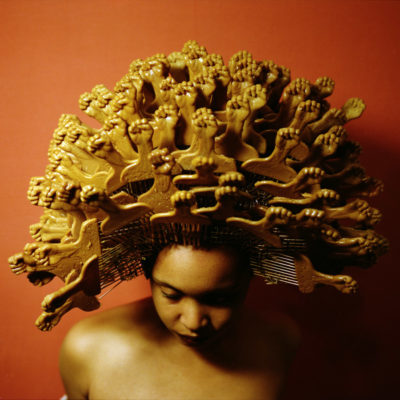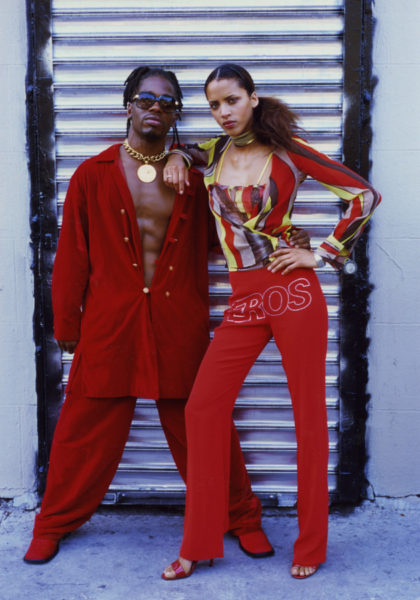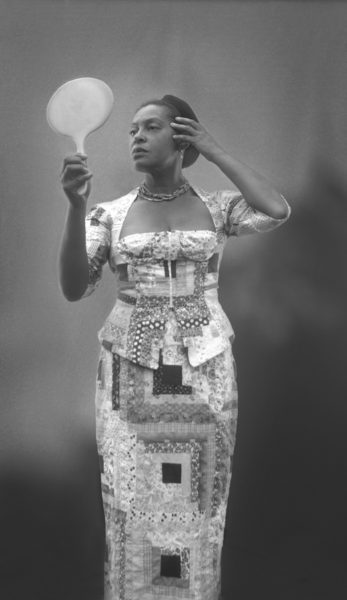
How do you want to be seen? Distinguished? Thoughtful? Stylish? Outrageous? Proud?
These are the words painted above the newest exhibit at the Northwest African American Museum (NAAM) called “Posing Beauty in African American Culture”
Curated by photographer and NYU professor Deborah Willis, the images in the exhibit form an eclectic collage of black expression shown in the faces and bodies of dolls, models, celebrities, activists, and just regular people you might see on the street.
From the black and white of a shirtless young Huey P. Newton holding a Bob Dylan record to Lil Kim with platinum hair, her midriff bare, mic to her mouth rocking a Queen Bee belt like a badass, these images are both the expected and the unexpected, posed and un-posed, raw, understated, and complex.
“I’m hoping it will inspire people to think about how they construct themselves both esthetically how they style themselves, but also how they pose themselves,” said Serenity Wise, the director of community engagement at the NAAM. “I’m a dancer so I think a lot about the pose. I think a lot about our body language and you know how we carry ourselves, so this show is right up my alley in that sense.”
As Wise and I walked through the exhibit together she pointed out her favorite piece, a man in a three-piece suit angling his body like a dancer against the backdrop of an ordinary street.
“He couldn’t get any more posed up — fresh — I mean it looks like the photograph was taken spontaneously when they met him on the street,” she laughed noting the distinctly east coast style of dress that reminded her of her own ties to Baltimore. “He’s like I don’t care if I have an interview to go to today, if I have a party to go to, I’m just gonna get dressed and be right outside McDonalds.”
As I walked around the exhibit I found myself staring at a portrait of a Barbie doll’s face. She was the deep tan of ambiguous ethnicity, her brown hair pulled back in a ponytail, one eye brown and one blue. The blue eyed side of her face was done up with make up, the lashes long, the cheek accentuate with blush whereas the brown eyed side was bare. The plumped up lips of the brown eyes side gives her the appearance of a crooked mouth.
It was like a picture of both Saturday morning chill and Saturday night swag all in one plastic face.

My mother didn’t like me playing with Barbie. In fact the only reason I had one is because my uncle gave me one and there is no diplomatic way to take a gift back from a child. Ironically he was also the uncle that also gave me what my mother feared Barbie would, a complex about my body.
Clothes shopping with my cousin, who was a year older than me, half my size and light skinned, with “good” hair that flowed down her back is the first real memory I have of beauty being comparative. My uncle cracked jokes when we couldn’t find matching outfits because I had to shop in the plus size section. Until that point I hadn’t made the mental leap that us looking different meant one of us (me) wasn’t pretty and one of us (her) was.
What followed in the years of attending predominantly white public schools did little to interrupt or contradict the seed of a distorted self-image that had been planted. I learned to see myself the way kids on the playground did, the way my gym teacher did, and it wasn’t particularly flattering.
Looking at pictures from my life in Wisconsin I almost never show my teeth. I stand up straight, but less out of confidence and more for the purpose of sucking in my stomach.
“On a really personal level something we can all tap into is that when somebody puts a camera in front of you and they say cheese you don’t just look at the camera and do exactly what you were doing before. You get into position,” explained Wise. “And what is it about the poses we choose to strike when we’re in front of a camera?”
This year especially has brought to the forefront a myriad of images of blackness posed and un-posed from black bodies shot dead and left to litter the street like garbage, to Beyonce grinning wickedly, dressed in a yellow ruffled dress slamming a baseball bat into a car window.

Whether black is beautiful, powerful, a mark of tragedy, fear-worthy, angry, or revolutionary depends as much on who is behind the lens taking the pictures as it does on who is posed in front of it. Morevover there are so many contributing factors to how someone will process the images before them.
These are conversations taking place throughout Seattle’s art community, from Donald Byrd dedicating an entire season of Spectrum Dance Theatre to the contemplation of race, to posters plastered on the sides of busses from the Kehinde Wiley exhibit at the SAM.
“It is really exciting to see all these institutions that haven’t historically been linked with African American culture with African American people starting to embrace that,” said Wise. “And to give them their credit, a number of them are not of the mentality that they can just do it on their own…’oh we’re going to talk about black things now and not engage black people’ like they are genuinely engaging in a lot of the community, working with black artists, working with us, reaching out to us and that’s really heartening to see.”
Beyond Seattle, Wise sees this trend of examining black aesthetic reflected nationally in the way that Beyonce’s Lemonade has been so critically acclaimed.
“What I love about Lemonade and why I feel like it actually relates to this show is that its so contemporary,” says Wise. “Usually that art tends to be reserved for some kind of elite presentation that people don’t tend to personally relate to, but everyone relates to Beyonce.”
Wise believes that “Posing Beauty” does the same thing.
“We all present ourselves in a certain type of way — usually in a way that is trying to convey some sense of our idea of beauty — and, you know, doing it in photographs so it’s individuals presenting themselves is such an immediate thing, it’s not conceptual,” she said. “It’s not like a Rothko on the wall, okay this color, how does this relate to me today? Posing beauty is glamorous and beautiful and very personal at the same time.”
See it for yourself at the NAAM. The exhibit will be up through September.

